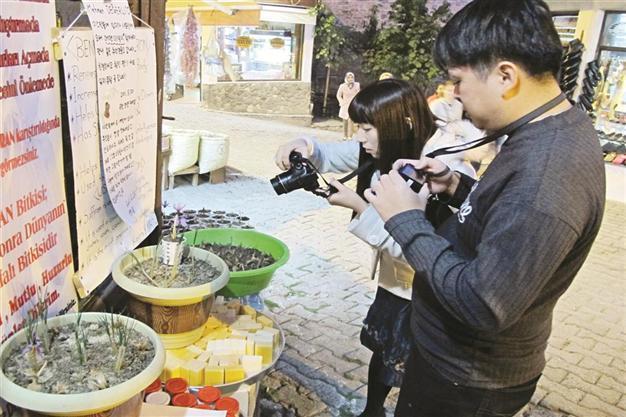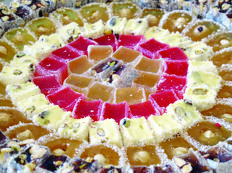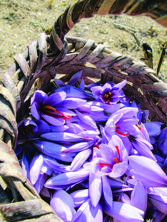Saffron flower finds home in Safranbolu
Wilco van HERPEN

Nowadays Safranbolu shops have a complete line of saffron products from lokum, soap and marmalade to eau de cologne.
Finally winter is about to end but, typical for Turkey, after a couple of days of beautiful sunny weather it can take you by surprise and change overnight. While writing this article I am freezing. A couple of days ago I walked around in Taksim and was clearly overdressed. This morning when I woke up I saw snow everywhere. The flowers in my garden are confused; all the trees are blossoming; all the tulips are flowering. My daffodils started to come out of the ground and when I looked around I saw even my saffron bulbs had started to sprout. Their leaves all liberated themselves from the dark and cold earth, finally able to breathe and make the bulb grow.
Last year I went to Safranbolu. I wanted to see if something had changed in the town because the last time I was there, about six years ago, there was hardly any saffron in Safranbolu. Quite strange for a place that has saffron in its name. The last couple of years there has been a kind of awareness spreading. Suddenly Safranbolu realized that they had to offer more than being just a little, cute, old Ottoman town. Shops like İmren realized already at an early stage that they could give more content to Safranbolu by making saffron lokum (Turkish delight made with saffron). Nowadays they have a complete line of saffron products from lokum, soap and marmalade to eau de cologne. But also the small shops do much more than just selling dried saffron. An old friend of mine, Mehmet, has a little shop in Safranbolu. Seeing each other again, we directly picked up our conversation where we left it the last time I saw him.

“Business has changed,” he told me. “I started selling saffron bulbs one or two years ago, and so many people want to have them for their garden.” At the same time he offered me a tea, of course with saffron. This with a bit of honey makes a beautiful tea. Years ago, he told me, you could find saffron everywhere in and around Safranbolu. Then suddenly people gave up cultivating saffron; it was too much of a hassle. “But in recent years they have rediscovered saffron. If you want I can recommend a couple of those places.” Well, who am I to refuse such a nice offer? If you want to see the saffron you have to leave early in the morning because that is when the flowers open up.
Saffron cosmeticsAfter finishing my tea and buying a couple of those saffron bulbs, I headed to another friend I wanted to see; Cem. He works in a family business that makes lokum, marmalade, eau de cologne and many more things. When I entered his shop it was as if I never left his place. Everything was exactly the same as the last time I visited Safranbolu. I was lucky to find Cem in the shop because, as he told me, nowadays he was very busy with the hotel and a shop that specializes in saffron cosmetics. “Come to the factory,” he invited me, and off we went. About 20 people work at the factory and all of them together produce the famous saffron lokum and many more things. When I arrived they were about to pour the saffron juice in the secret sugar mixture. Once they poured it in the mixture took on a beautiful soft yellow color. After heating the mixture again the saffron lokum was poured into big trays and left to cool down. Once the mixture was cool enough the workers in the factory took the trays and turned them upside down. Another worker was cutting the lokum, and after being dipped in grated coconut the saffron lokum was ready. The nice thing about being in such a factory is that while the workers were preparing the lokum and put the lokum in boxes, I could eat as much as I wanted.
 Picking flowers
Picking flowers The next day I had to get up early. Saffron flowers are very delicate and give the best taste when they are picked at the moment the flower opens. This happens when the sun is rising, so I had to be there at around 6:30 a.m. When I arrived a woman was already working in the field. With a small basket in her hand she walked from one flower to another, checking if they had opened enough to pick the flower. The problem was that the flowers do not open all at the same time, so she was walking around without following the rows of the flowerbeds. But with her trained eye she already saw from a distance which flower could be picked. Collecting all the saffron flowers she finished her job around 10 a.m. She invited me to come to her home where she sat down in the shade and one by one started to separate the stamens from the flower. It took her hours to remove all the stamens, and in the end she had a small bowl of fresh saffron on a tray. These saffron stamens have to be dried quickly so the color and aroma will not be lost. Her work was finished; all around her were saffron flowers lying on the ground, quickly losing their fresh color and melting away in the strong autumn sun.
For me, being a former chef, this had been such a fascinating and valuable couple of days. Many of my colleagues work with saffron every day, but they have never had the chance to see where it comes from and how it was being produced. I saw it in Safranbolu, and if you have any affinity for cooking, I strongly recommend you go to Safranbolu this coming autumn and see it for yourself.

 “Business has changed,” he told me. “I started selling saffron bulbs one or two years ago, and so many people want to have them for their garden.” At the same time he offered me a tea, of course with saffron. This with a bit of honey makes a beautiful tea. Years ago, he told me, you could find saffron everywhere in and around Safranbolu. Then suddenly people gave up cultivating saffron; it was too much of a hassle. “But in recent years they have rediscovered saffron. If you want I can recommend a couple of those places.” Well, who am I to refuse such a nice offer? If you want to see the saffron you have to leave early in the morning because that is when the flowers open up.
“Business has changed,” he told me. “I started selling saffron bulbs one or two years ago, and so many people want to have them for their garden.” At the same time he offered me a tea, of course with saffron. This with a bit of honey makes a beautiful tea. Years ago, he told me, you could find saffron everywhere in and around Safranbolu. Then suddenly people gave up cultivating saffron; it was too much of a hassle. “But in recent years they have rediscovered saffron. If you want I can recommend a couple of those places.” Well, who am I to refuse such a nice offer? If you want to see the saffron you have to leave early in the morning because that is when the flowers open up.  Picking flowers
Picking flowers